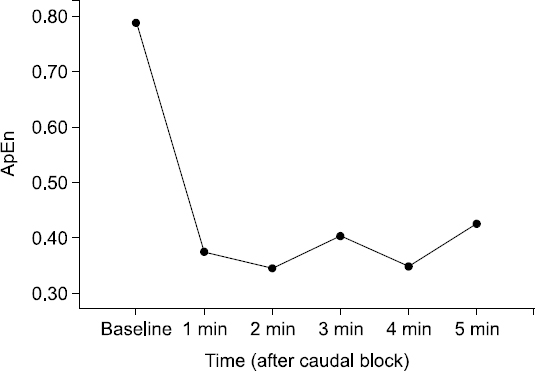1. Schuepfer G, Konrad C, Schmeck J, Poortmans G, Staffelbach B, Jöhr M. Generating a learning curve for pediatric caudal epidural blocks:an empirical evaluation of technical skills in novice and experienced anesthetists. Reg Anesth Pain Med. 2000; 25:385–8. DOI:
10.1097/00115550-200007000-00011. PMID:
10925935.
2. Suresh S, Long J, Birmingham PK, De Oliveira GS Jr. Are caudal blocks for pain control safe in children?an analysis of 18,650 caudal blocks from the Pediatric Regional Anesthesia Network (PRAN) database. Anesth Analg. 2015; 120:151–6. DOI:
10.1213/ANE.0000000000000446. PMID:
25393589.
3. Lewis MP, Thomas P, Wilson LF, Mulholland RC. The ‘whoosh’ test. A clinical test to confirm correct needle placement in caudal epidural injections. Anaesthesia. 1992; 47:57–8. DOI:
10.1111/j.1365-2044.1992.tb01957.x. PMID:
1536408.
5. Abukawa Y, Hiroki K, Morioka N, Iwakiri H, Fukada T, Higuchi H, et al. Ultrasound versus anatomical landmarks for caudal epidural anesthesia in pediatric patients. BMC Anesthesiol. 2015; 15:102. DOI:
10.1186/s12871-015-0082-0. PMID:
26169595. PMCID:
PMC4499894.
7. Seyedhejazi M, Moghadam A, Sharabiani BA, Golzari SE, Taghizadieh N. Success rates and complications of awake caudal versus spinal block in preterm infants undergoing inguinal hernia repair:A prospective study. Saudi J Anaesth. 2015; 9:348–52. DOI:
10.4103/1658-354X.154704. PMID:
26543447. PMCID:
PMC4610074.
8. Ghai B, Makkar JK, Behra BK, Rao KP. Is a fall in baseline heart rate a reliable predictor of a successful single shot caudal epidural in children? Paediatr Anaesth. 2007; 17:552–6. DOI:
10.1111/j.1460-9592.2006.02179.x. PMID:
17498017.
9. Adler AC, Schwartz DA, Begley A, Friderici J, Connelly NR. Heart rate response to a caudal block in children anesthetized with sevoflurane after ultrasound confirmation of placement. Paediatr Anaesth. 2015; 25:1274–9. DOI:
10.1111/pan.12752. PMID:
26415988.
10. Talwar V, Tyagi R, Mullick P, Gogia AR. Comparison of ‘whoosh’ and modified ‘swoosh’ test for identification of the caudal epidural space in children. Paediatr Anaesth. 2006; 16:134–9. DOI:
10.1111/j.1460-9592.2005.01729.x. PMID:
16430408.
11. Verghese ST, Mostello LA, Patel RI, Kaplan RF, Patel KM. Testing anal sphincter tone predicts the effectiveness of caudal analgesia in children. Anesth Analg. 2002; 94:1161–4. DOI:
10.1097/00000539-200205000-00019. PMID:
11973180.
12. Roberts SA, Guruswamy V, Galvez I. Caudal injectate can be reliably imaged using portable ultrasound--a preliminary study. Paediatr Anaesth. 2005; 15:948–52. DOI:
10.1111/j.1460-9592.2005.01606.x. PMID:
16238555.
14. Kim YU, Cheong Y, Kong YG, Lee J, Kim S, Choi HG, et al. The prolongation of pulse transit time after a stellate ganglion block:An objective indicator of successful block. Pain Res Manag. 2015; 20:305–8. DOI:
10.1155/2015/324514. PMCID:
PMC4676500.
15. Babchenko A, Davidson E, Adler D, Ginosar Y, Kurz V, Nitzan M. Increase in pulse transit time to the foot after epidural anaesthesia treatment. Med Biol Eng Comput. 2000; 38:674–9. DOI:
10.1007/BF02344874. PMID:
11217886.
16. Chen YQ, Jin XJ, Liu ZF, Zhu MF. Effects of stellate ganglion block on cardiovascular reaction and heart rate variability in elderly patients during anesthesia induction and endotracheal intubation. J Clin Anesth. 2015; 27:140–5. DOI:
10.1016/j.jclinane.2014.06.012. PMID:
25559299.
17. Simeoforidou M, Vretzakis G, Chantzi E, Bareka M, Tsiaka K, Iatrou C, et al. Effect of interscalene brachial plexus block on heart rate variability. Korean J Anesthesiol. 2013; 64:432–8. DOI:
10.4097/kjae.2013.64.5.432. PMID:
23741566. PMCID:
PMC3668105.
18. Crellin D, Sullivan TP, Babl FE, O’Sullivan R, Hutchinson A. Analysis of the validation of existing behavioral pain and distress scales for use in the procedural setting. Paediatr Anaesth. 2007; 17:720–33. DOI:
10.1111/j.1460-9592.2007.02218.x. PMID:
17596217.
19. Song IK, Park YH, Lee JH, Kim JT, Choi IH, Kim HS. Randomized controlled trial on preemptive analgesia for acute postoperative pain management in children. Paediatr Anaesth. 2016; 26:438–43. DOI:
10.1111/pan.12864. PMID:
26890267.
20. Kang JE, Song IK, Lee JH, Hur M, Kim JT, Kim HS. Pulse transit time shows vascular changes caused by propofol in children. J Clin Monit Comput. 2015; 29:533–7. DOI:
10.1007/s10877-015-9680-0. PMID:
25750017.
21. Stein PK, Bosner MS, Kleiger RE, Conger BM. Heart rate variability:a measure of cardiac autonomic tone. Am Heart J. 1994; 127:1376–81. DOI:
10.1016/0002-8703(94)90059-0.
22. Toweill DL, Kovarik WD, Carr R, Kaplan D, Lai S, Bratton S, et al. Linear and nonlinear analysis of heart rate variability during propofol anesthesia for short-duration procedures in children. Pediatr Crit Care Med. 2003; 4:308–14. DOI:
10.1097/01.PCC.0000074260.93430.6A. PMID:
12831412.
24. Silvetti MS, Drago F, Ragonese P. Heart rate variability in healthy children and adolescents is partially related to age and gender. Int J Cardiol. 2001; 81:169–74. DOI:
10.1016/S0167-5273(01)00537-X.





 PDF
PDF Citation
Citation Print
Print


 XML Download
XML Download